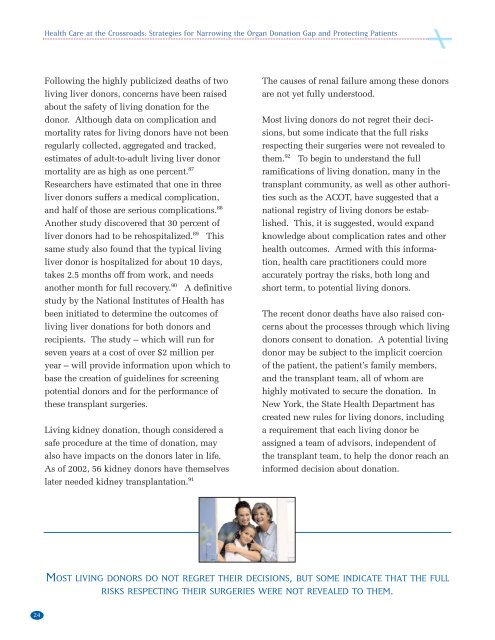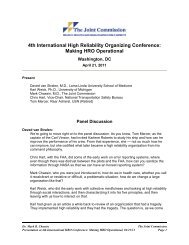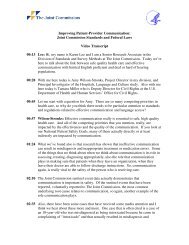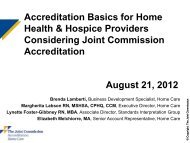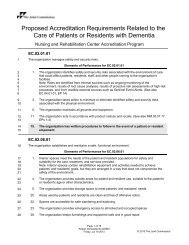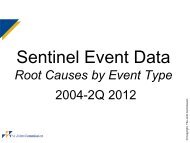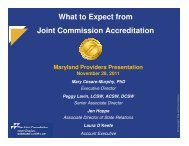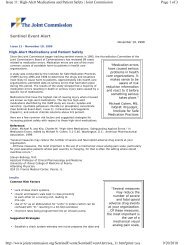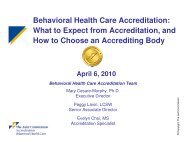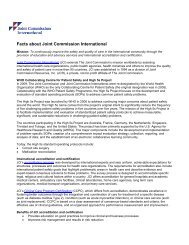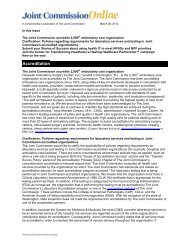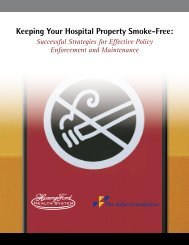Health Care at the Crossroads: Strategies for ... - Joint Commission
Health Care at the Crossroads: Strategies for ... - Joint Commission
Health Care at the Crossroads: Strategies for ... - Joint Commission
You also want an ePaper? Increase the reach of your titles
YUMPU automatically turns print PDFs into web optimized ePapers that Google loves.
<strong>Health</strong> <strong>Care</strong> <strong>at</strong> <strong>the</strong> <strong>Crossroads</strong>: Str<strong>at</strong>egies <strong>for</strong> Narrowing <strong>the</strong> Organ Don<strong>at</strong>ion Gap and Protecting P<strong>at</strong>ients<br />
Following <strong>the</strong> highly publicized de<strong>at</strong>hs of two<br />
living liver donors, concerns have been raised<br />
about <strong>the</strong> safety of living don<strong>at</strong>ion <strong>for</strong> <strong>the</strong><br />
donor. Although d<strong>at</strong>a on complic<strong>at</strong>ion and<br />
mortality r<strong>at</strong>es <strong>for</strong> living donors have not been<br />
regularly collected, aggreg<strong>at</strong>ed and tracked,<br />
estim<strong>at</strong>es of adult-to-adult living liver donor<br />
mortality are as high as one percent. 87<br />
Researchers have estim<strong>at</strong>ed th<strong>at</strong> one in three<br />
liver donors suffers a medical complic<strong>at</strong>ion,<br />
and half of those are serious complic<strong>at</strong>ions. 88<br />
Ano<strong>the</strong>r study discovered th<strong>at</strong> 30 percent of<br />
liver donors had to be rehospitalized. 89 This<br />
same study also found th<strong>at</strong> <strong>the</strong> typical living<br />
liver donor is hospitalized <strong>for</strong> about 10 days,<br />
takes 2.5 months off from work, and needs<br />
ano<strong>the</strong>r month <strong>for</strong> full recovery. 90 A definitive<br />
study by <strong>the</strong> N<strong>at</strong>ional Institutes of <strong>Health</strong> has<br />
been initi<strong>at</strong>ed to determine <strong>the</strong> outcomes of<br />
living liver don<strong>at</strong>ions <strong>for</strong> both donors and<br />
recipients. The study – which will run <strong>for</strong><br />
seven years <strong>at</strong> a cost of over $2 million per<br />
year – will provide in<strong>for</strong>m<strong>at</strong>ion upon which to<br />
base <strong>the</strong> cre<strong>at</strong>ion of guidelines <strong>for</strong> screening<br />
potential donors and <strong>for</strong> <strong>the</strong> per<strong>for</strong>mance of<br />
<strong>the</strong>se transplant surgeries.<br />
Living kidney don<strong>at</strong>ion, though considered a<br />
safe procedure <strong>at</strong> <strong>the</strong> time of don<strong>at</strong>ion, may<br />
also have impacts on <strong>the</strong> donors l<strong>at</strong>er in life.<br />
As of 2002, 56 kidney donors have <strong>the</strong>mselves<br />
l<strong>at</strong>er needed kidney transplant<strong>at</strong>ion. 91<br />
The causes of renal failure among <strong>the</strong>se donors<br />
are not yet fully understood.<br />
Most living donors do not regret <strong>the</strong>ir decisions,<br />
but some indic<strong>at</strong>e th<strong>at</strong> <strong>the</strong> full risks<br />
respecting <strong>the</strong>ir surgeries were not revealed to<br />
<strong>the</strong>m. 92 To begin to understand <strong>the</strong> full<br />
ramific<strong>at</strong>ions of living don<strong>at</strong>ion, many in <strong>the</strong><br />
transplant community, as well as o<strong>the</strong>r authorities<br />
such as <strong>the</strong> ACOT, have suggested th<strong>at</strong> a<br />
n<strong>at</strong>ional registry of living donors be established.<br />
This, it is suggested, would expand<br />
knowledge about complic<strong>at</strong>ion r<strong>at</strong>es and o<strong>the</strong>r<br />
health outcomes. Armed with this in<strong>for</strong>m<strong>at</strong>ion,<br />
health care practitioners could more<br />
accur<strong>at</strong>ely portray <strong>the</strong> risks, both long and<br />
short term, to potential living donors.<br />
The recent donor de<strong>at</strong>hs have also raised concerns<br />
about <strong>the</strong> processes through which living<br />
donors consent to don<strong>at</strong>ion. A potential living<br />
donor may be subject to <strong>the</strong> implicit coercion<br />
of <strong>the</strong> p<strong>at</strong>ient, <strong>the</strong> p<strong>at</strong>ient’s family members,<br />
and <strong>the</strong> transplant team, all of whom are<br />
highly motiv<strong>at</strong>ed to secure <strong>the</strong> don<strong>at</strong>ion. In<br />
New York, <strong>the</strong> St<strong>at</strong>e <strong>Health</strong> Department has<br />
cre<strong>at</strong>ed new rules <strong>for</strong> living donors, including<br />
a requirement th<strong>at</strong> each living donor be<br />
assigned a team of advisors, independent of<br />
<strong>the</strong> transplant team, to help <strong>the</strong> donor reach an<br />
in<strong>for</strong>med decision about don<strong>at</strong>ion.<br />
MOST LIVING DONORS DO NOT REGRET THEIR DECISIONS, BUT SOME INDICATE THAT THE FULL<br />
RISKS RESPECTING THEIR SURGERIES WERE NOT REVEALED TO THEM.<br />
24


